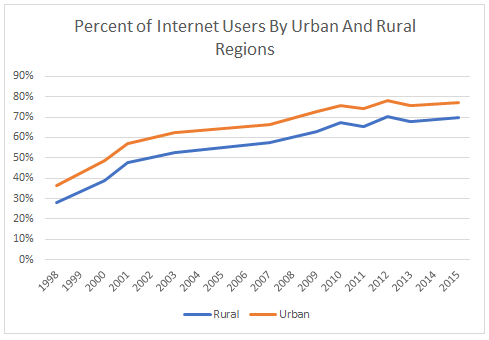Insight
March 1, 2017
How Well Do Rural Broadband Subsidies Work?
Among the priorities of the Trump administration, a federal infrastructure plan tops the list. While specifics are thin, some are pushing for the plan to include broadband, especially in rural areas, which is the topic of discussion for a Senate hearing today. But this isn’t the federal government’s first time at the rodeo, similar projects have been tried, failing to live up to their hype. As proposals began to solidify, policymakers should be cautious, since the evidence for federally supported rural broadband development remains thin.
The presence of a rural-urban divide in both broadband availability and adoption is well supported in surveys and is documented in the Census. While other demographic disparities in broadband adoption seem to be closing, the difference in Internet use by those in urban and rural regions remains stubbornly consistent as the chart below shows. However, this isn’t to say that rural areas don’t have access to Internet services, but rather lag in adoption.
At the same time, broadband adoption is typically associated with better economic outcomes including employment, number of businesses, and businesses in information technology sectors. Knowledge intensive firms often locate their business based on broadband availability, leading to a clustering of these businesses in regions with widespread access. Controlling for economic and demographic variables, local employment tends to ticks upward with the number of broadband providers. Among countries, the relationship also holds. One study from the World Bank concluded that a 10 percentage point increase in fixed broadband penetration increases country-level GDP growth by 1.2 percent.
Relying on the general thrust of these studies, governments of all sizes have pursued a range of policies to promote broadband uptake and upgrade existing networks, such as the currently proposed broadband subsidies.
Correlation, however, doesn’t equal causation, and so policymakers today should be wary of just how far broadband projects can take rural communities. Indeed, this is where the academic community and policymakers tend to part. While both agree in the broad positive relationship, research on subsidy programs often finds that the programs underperform.
For years, the United States Department of Agriculture has supported the Broadband Loan program under the Farm Bill. This program directs federal money to private providers to make high-speed Internet available. Yet, economic analysis of loans made in the early 2000s found “no evidence that loans received as part of the current Broadband Loan program have had a measurable positive impact on recipient communities.” At first, the program seemed to have a positive impact on communities when the analysis focused at the ZIP code level, but when county level data was used instead, the positive and negative effects on different sectors cancelled each other out.
The Obama-era American Recovery and Reinvestment Act, colloquially known as the Stimulus, followed a similar trajectory. In total, $7.2 billion of the act was allocated to extend broadband internet access, including $2.5 billion for rural communities via the Broadband Infrastructure Program (BIP), which was administered by the Rural Utilities Service (RUS). Under closer look, research on a sample of the communities found that broadband adoption did increase in the targeted communities due to BIP, but the economic and quality of life measurements lauded by the Obama administration saw little change.
More scrutiny needs to be placed on program administration as well. An inquiry from the Government Accountability Office discovered that 14 percent of all BIP projects were terminated for a variety of reasons. Subsequent reporting uncovered serious mismanagement. Before any money even left the door, more than $300 million in loans and grants were pulled. Localities often struggled to finance their share of the proposals, while regulatory processes at the local level could barely keep up, slowing down the placement of new fiber cables and wireless towers. Jonathan Adelstein originally argued for the program before Congress in 2011, he claimed its broadband investments would benefit “7 million rural Americans.” Such a statement hardly holds up today.
As Senator Thune pointed out, many Americans do live in rural areas, away from the highest-ticket projects their tax dollars might fund, so it is important that a bill is constructed to benefit everyone from improvements to digital networks. The next step needs to be taken. Most of what has been proposed so far is simply a rehash of past programs. And this time around, past performance does guarantee future results.











